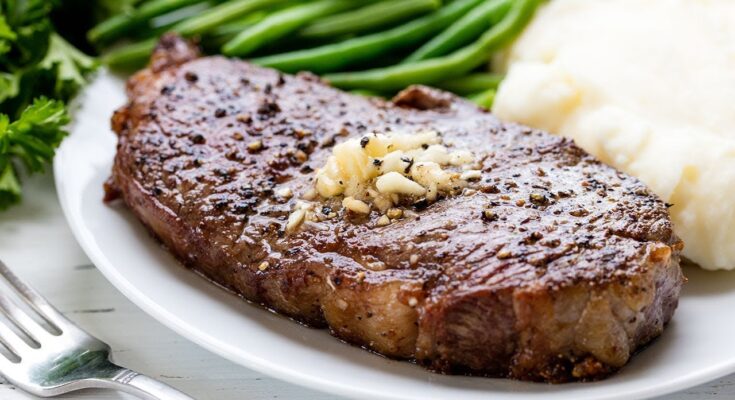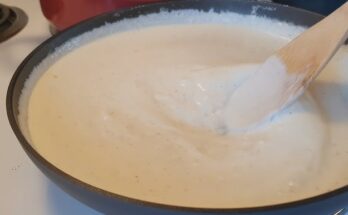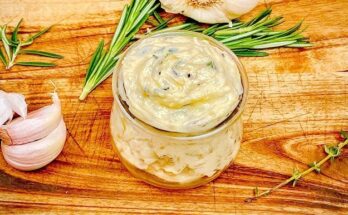Beef Flank Steak Recipe: Flank steak is one of those cuts that often gets overlooked until someone finally gives it a try and then wonders, “Where has this been all my life?” If you’re looking for a protein-packed, budget-friendly, and flavor-rich steak option, look no further. This recipe is going to walk you through everything—from what flank steak actually is, to how to choose it, prepare it, cook it, and even slice it like a pro. We’re not just throwing some meat on a grill here—we’re building layers of flavor, texture, and tenderness in every bite.
Whether you’re a home chef or just a weekend grill warrior, you’ll appreciate this easy-to-follow, flavor-packed guide. Grab your apron, fire up your favorite skillet or grill, and let’s turn this humble cut into a restaurant-quality dish that’ll have your guests asking for seconds.
What Is Flank Steak?
Flank steak is a lean, flavorful cut of beef that comes from the abdominal muscles of the cow. It’s long, flat, and somewhat fibrous in texture, making it a prime candidate for marinating and quick, high-heat cooking methods. Unlike ribeye or filet mignon, which come from more tender parts of the cow, flank steak needs a little more TLC—but trust us, it’s worth it.
This cut is packed with meaty, beef-forward flavor. It doesn’t have a ton of marbling, which means it’s not as fatty or melt-in-your-mouth as a ribeye, but when cooked and sliced properly, flank steak is incredibly satisfying. The key lies in how you treat it—marinate, cook it hot and fast, and slice it against the grain. More on that later.
Flank steak is perfect for grilling, stir-frying, broiling, or pan-searing, and it’s a staple in recipes like fajitas, steak salads, and Asian-inspired dishes.
Why Flank Steak is a Popular Choice
So, why do so many home cooks and chefs swear by flank steak? For starters, it’s affordable. You get a lot of steak for your money, especially compared to premium cuts. But the real reason is its versatility and deep beef flavor. It can soak up marinades like a sponge, making it the perfect canvas for bold, exciting flavors.
Flank steak also cooks quickly. You’re not stuck in the kitchen or at the grill for hours—just a few minutes per side and boom, you’ve got dinner. Plus, because it’s lean, it’s also a healthier option if you’re watching your fat intake. It fits perfectly into high-protein, low-carb, or keto diets.
Another major plus? It’s incredibly satisfying. With the right technique, flank steak becomes juicy, tender, and packed with flavor. It’s a crowd-pleaser that works just as well for a weeknight dinner as it does for a backyard BBQ.
Health Benefits of Flank Steak
Flank steak isn’t just delicious—it’s also good for you. It’s a lean cut, which means it’s lower in fat than ribeye or New York strip. A 3-ounce serving of flank steak contains about:
- 160 calories
- 23 grams of protein
- 6 grams of fat
- 0 grams of carbs
It’s also rich in important nutrients like iron, zinc, and B vitamins—especially B12, which is crucial for energy and brain function. If you’re on a high-protein diet, trying to build muscle, or just need a satisfying meal that won’t weigh you down, flank steak checks all the boxes.
But like all red meat, moderation is key. Pair it with fiber-rich veggies and whole grains, and you’ve got a balanced meal that’s both hearty and healthy.
Choosing the Right Cut of Flank Steak
Picking the right piece of flank steak at the store or butcher counter can make a big difference. Look for a steak that:
- Has even thickness from end to end.
- Is a deep red color—this means it’s fresh.
- Has minimal fat on the outside (you’ll trim it later).
- Feels firm to the touch, not mushy.
Avoid pieces that look grey, overly wet, or have a strong smell. Fresh flank steak has a mild, meaty aroma.
You can also ask your butcher to tenderize it for you using a meat mallet or blade tenderizer. This helps break down the muscle fibers, making the steak more tender when cooked.
List of Ingredients You’ll Need
Essential Ingredients
- 1.5 to 2 pounds of flank steak
- 3 tablespoons olive oil
- 1/4 cup soy sauce
- 2 tablespoons Worcestershire sauce
- 2 tablespoons balsamic vinegar
- 1 tablespoon Dijon mustard
- 2 cloves garlic, minced
- 1 teaspoon onion powder
- 1 teaspoon smoked paprika
- Salt and pepper to taste
Optional Add-ins for Extra Flavor
- 1 tablespoon honey or brown sugar (for a hint of sweetness)
- 1/2 teaspoon red pepper flakes (if you like it spicy)
- 1 teaspoon fresh chopped rosemary or thyme
- Juice of 1 lime (for citrus zing)
These ingredients form a powerhouse marinade that tenderizes the meat and infuses it with complex, savory flavor.
Kitchen Tools You’ll Need
You don’t need fancy equipment to make a killer flank steak, but having the right tools helps:
- Sharp chef’s knife
- Cutting board
- Mixing bowl or zip-top bag (for marinating)
- Tongs
- Cast iron skillet or grill
- Meat thermometer (optional but helpful)
- Aluminum foil (for resting the meat)
If you’re grilling, make sure your grill is clean and preheated. If using a skillet, a heavy-duty cast iron pan works best for that perfect sear.
How to Prepare Flank Steak for Cooking
Getting your flank steak ready the right way is half the battle. This isn’t a cut you can just toss onto a grill or pan straight from the package—at least not if you want it to be tender, flavorful, and downright mouthwatering.
Trimming and Tenderizing
Start by removing any excess silver skin or fat on the surface of the steak. Silver skin is that thin, shiny membrane that doesn’t break down during cooking and can make your steak chewy. Use a sharp knife to carefully trim it away.
Next, tenderize the steak by using a meat mallet or the back of a heavy pan. Lightly pound both sides of the meat to break up the muscle fibers. This helps make it less tough after cooking and allows your marinade to penetrate deeper.
Don’t go overboard—just a few good whacks on each side will do. You want to break the surface, not flatten the steak into a pancake.
Marinating for Maximum Flavor
Flank steak loves a good marinade. Since it’s lean and has lots of muscle fibers, marinating is key to making it juicy and flavorful.
Place the steak in a large zip-top bag or shallow dish. Pour the marinade over it (more on that below), making sure the steak is fully coated. Seal the bag or cover the dish and place it in the fridge for at least 2 hours, or ideally overnight.
Pro tip: Don’t let it marinate for more than 24 hours. Too much time in acidic marinades (like those with vinegar or citrus) can make the meat mushy instead of tender.
Best Marinade for Flank Steak
This marinade is a flavor bomb. It balances salty, savory, sweet, and tangy elements—all of which help tenderize the meat and bring out that rich beefy flavor.
Easy Homemade Marinade Recipe
Here’s what you’ll need:
- 1/4 cup soy sauce
- 3 tablespoons olive oil
- 2 tablespoons balsamic vinegar
- 2 tablespoons Worcestershire sauce
- 1 tablespoon Dijon mustard
- 2 cloves garlic (minced)
- 1 teaspoon onion powder
- 1 teaspoon smoked paprika
- 1 tablespoon brown sugar or honey (optional for sweetness)
- Juice of 1 lime
- Freshly ground black pepper
Whisk everything together in a bowl until fully combined. Pour the marinade over your prepared flank steak, and make sure it’s coated evenly. Massage it into the meat a bit, seal it up, and refrigerate.
The soy sauce brings salt and umami, the vinegar and lime juice help tenderize, and the mustard and spices build flavor complexity. It’s a game changer.
Step-by-Step Guide to Cooking Flank Steak
This is the moment where everything comes together. Below, we’ll break down the steps for cooking your marinated flank steak using different methods. Let’s start with the basics.
Step 1: Preparing the Steak
Remove the steak from the marinade and let it come to room temperature—about 20–30 minutes on the counter. This helps it cook more evenly.
Pat it dry with paper towels. Don’t skip this part. Wet meat doesn’t sear well, and you want that gorgeous crust.
Step 2: Marinating the Steak
By now, your steak should be fully marinated and packed with flavor. Discard the used marinade (or boil it first if you want to use it as a sauce).
Optional step: lightly brush the steak with a tiny bit of oil and sprinkle with fresh black pepper before cooking.
Step 3: Cooking Methods
You’ve got a few excellent choices when it comes to cooking flank steak:
Grilling (Best Flavor)
- Preheat your grill to high heat (around 450–500°F).
- Place the steak on the grill and cook for 4–5 minutes per side for medium-rare.
- Use tongs to flip once—don’t press it down!
- Remove when internal temp hits 130–135°F.
Pan-Searing (Quick & Easy)
- Heat a cast iron skillet over medium-high heat until screaming hot.
- Add a tablespoon of oil, then place the steak in the pan.
- Sear for 4–5 minutes per side, turning only once.
- Check doneness with a meat thermometer.
Oven Broiling (Hands-Off Method)
- Preheat broiler and place steak on a foil-lined baking sheet.
- Broil about 4–6 inches from the flame, 5–6 minutes per side.
- Remove and rest immediately.
Step 4: Resting and Slicing
Once cooked, rest your steak for 10 minutes. This is crucial—it allows the juices to redistribute so you don’t end up with dry meat.
Then, using a sharp knife, slice the steak against the grain. This means cutting perpendicular to the muscle fibers. It makes the meat more tender and easier to chew.
Tips for Grilling Flank Steak
Grilling is the go-to method for many, and for good reason—it adds smoky char and deep flavor. Here are some top tips to make sure your steak comes out perfect:
- Preheat properly. A hot grill ensures a good sear and prevents sticking.
- Oil the grates. Use tongs and a paper towel dipped in oil to wipe the grates before placing the steak.
- Use direct heat. Flank steak thrives over direct flames.
- Don’t move it around. Let it sit and develop a nice crust before flipping.
- Use a thermometer. Medium-rare is around 130°F. Don’t guess.
- Let it rest. We can’t stress this enough—juicy steak comes from a little patience.
If you nail these basics, you’ll get a beautifully seared, juicy steak with those perfect grill marks that make everyone go, “Whoa.”
Pan-Searing Flank Steak – Quick & Juicy
If you don’t have a grill or just want something fast, pan-searing flank steak is a fantastic option. You still get a gorgeous crust, rich flavor, and juicy texture—with less fuss and mess.
How to Pan-Sear Flank Steak Like a Pro
- Heat a heavy skillet (cast iron is best) over medium-high heat. Give it a good 3-5 minutes to get properly hot.
- Add 1 tablespoon of high-smoke-point oil like avocado or canola oil.
- Place the steak in the pan, laying it away from you to avoid splatter.
- Sear without moving for 4–5 minutes until a deep brown crust forms.
- Flip using tongs and sear the other side for another 4–5 minutes.
- Optional: add a knob of butter, crushed garlic, and a sprig of thyme or rosemary to the pan and spoon the melted butter over the steak as it finishes cooking (a technique known as basting).
- Check internal temperature with a meat thermometer. You want:
- 125–130°F for rare
- 130–135°F for medium-rare
- 135–145°F for medium
Once done, remove from the pan and let it rest on a cutting board for 10 minutes.
Pan-searing gives you control over the cooking process, and that butter baste at the end? Game changer. It adds flavor, richness, and a beautiful glossy finish.
How to Slice Flank Steak the Right Way
Slicing flank steak correctly is just as important as cooking it properly. Why? Because flank steak has long, visible muscle fibers that can be tough if you cut the wrong way.
The Secret: Slice Against the Grain
Look closely at the cooked steak. You’ll notice lines running across it—those are the muscle fibers or “grain.” To make each bite tender and easy to chew:
- Cut perpendicular to the grain, not along it.
- Use a very sharp knife to make thin slices, about 1/4 inch thick.
- Hold the knife at a slight angle (bias slicing) to maximize surface area and tenderness.
Pro tip: Slice the steak after it’s rested, and if the grain runs at an angle, rotate the steak to maintain your against-the-grain cut. This small step makes a huge difference in texture.
Serving Suggestions
Once your beautifully cooked and sliced flank steak is ready, it’s time to plate it up. This steak is so versatile—it plays well with dozens of different sides and themes.
Best Side Dishes
Here are some awesome pairings to round out your meal:
- Garlic mashed potatoes
- Grilled or roasted vegetables (like asparagus, bell peppers, or zucchini)
- Creamy coleslaw or broccoli slaw
- Corn on the cob
- Chimichurri or garlic herb butter
- Roasted sweet potatoes or wedges
If you want something lighter:
- Quinoa or couscous salad
- Cauliflower rice or zoodles
- Green salad with a citrus vinaigrette
Creative Ways to Serve Flank Steak
Flank steak is a champion in meal-prep and leftovers. Here are some ideas:
- Flank steak tacos with avocado, lime, and pickled onions
- Steak salad bowls with arugula, cherry tomatoes, feta, and balsamic glaze
- Beef fajitas with sautéed peppers and onions
- Asian-style stir-fry with soy-ginger glaze and steamed rice
- Steak sandwiches on toasted ciabatta with aioli and greens
The flavor is bold enough to shine through any style, and leftovers taste just as good cold or reheated.
Storage and Reheating Tips
You cooked the perfect steak—don’t ruin it with poor storage or reheating. Here’s how to keep it fresh and flavorful for days.
How to Store Cooked Flank Steak
- Let it cool completely.
- Store in an airtight container or tightly wrapped in foil.
- Keep in the refrigerator for up to 4 days.
- For longer storage, freeze in freezer-safe bags for up to 3 months.
Tip: Slice the steak before storing for easier use in salads, wraps, or bowls later.
Reheating Flank Steak Without Drying It Out
- Microwave: Place slices on a plate with a damp paper towel on top. Microwave in 30-second bursts.
- Stovetop: Heat in a skillet with a little oil or beef broth to keep it moist.
- Oven: Wrap in foil and reheat at 300°F for 10–15 minutes.
- Don’t overheat—just warm it through.
Avoid reheating multiple times. Take out only what you need and keep the rest sealed tight.
Common Mistakes to Avoid with Flank Steak
Even though flank steak is easy to cook, a few simple missteps can turn it tough or flavorless. Let’s make sure you don’t fall into those traps.
Mistake #1: Not Marinating Long Enough
Flank steak needs a few hours in the marinade to tenderize and develop flavor. A quick 15-minute soak isn’t going to cut it. Aim for at least 2 hours, or overnight for best results.
Mistake #2: Overcooking the Steak
This is the most common issue. Because flank steak is lean, it becomes tough and chewy if you go beyond medium doneness. Use a meat thermometer and pull it at 130–135°F for medium-rare.
Mistake #3: Slicing With the Grain
This is a big one. Cutting with the grain leaves long, chewy fibers. Always slice against the grain to shorten those fibers and make each bite tender.
Mistake #4: Skipping the Rest
Resting allows the juices to redistribute. Slice too soon and all that flavor runs out onto your cutting board.
Mistake #5: Not Preheating the Grill or Pan
A hot surface gives you that delicious sear and keeps the meat from sticking. Always preheat for a few minutes before cooking.
Avoiding these simple errors will guarantee you a flank steak that’s bursting with flavor and tender enough to rival any high-end steakhouse.
FAQs about Beef Flank Steak Recipe
1. How long should I marinate flank steak?
For best results, marinate flank steak for at least 2 hours and up to 24 hours. Anything less and the flavor won’t penetrate fully; anything more and the acid in the marinade could break down the meat too much.
2. Can I cook flank steak in the oven?
Yes! Use your oven’s broiler. Place the steak on a baking sheet and broil 4–6 inches from the heat for about 5–6 minutes per side, depending on thickness. Always rest before slicing.
3. What is the best doneness for flank steak?
Medium-rare (130–135°F) is ideal for flank steak. Going beyond that can make the steak dry and chewy, since it’s a lean cut without much fat to cushion it.
4. Can I freeze cooked flank steak?
Absolutely. Slice the steak and store in a freezer-safe bag or container. Freeze for up to 3 months. When ready to eat, thaw overnight in the fridge and reheat gently to preserve tenderness.
5. Is flank steak the same as skirt steak?
No, but they’re similar. Skirt steak comes from the diaphragm, is thinner, and has more marbling. Flank steak is thicker and leaner. Both can be used similarly, but cooking times and textures vary slightly.
Conclusion
Flank steak might not have the fame of a ribeye or filet mignon, but when it’s done right? It’s a game changer. With the right marinade, quick and hot cooking, and proper slicing, this lean cut turns into a flavor-packed centerpiece that’s perfect for weeknight dinners, weekend grilling, and everything in between.
Now that you’ve got the step-by-step roadmap—from picking the cut to slicing and serving—you’re fully equipped to cook the best flank steak of your life. So grab those ingredients, fire up that grill or skillet, and get ready to impress your family, friends, or just yourself.



